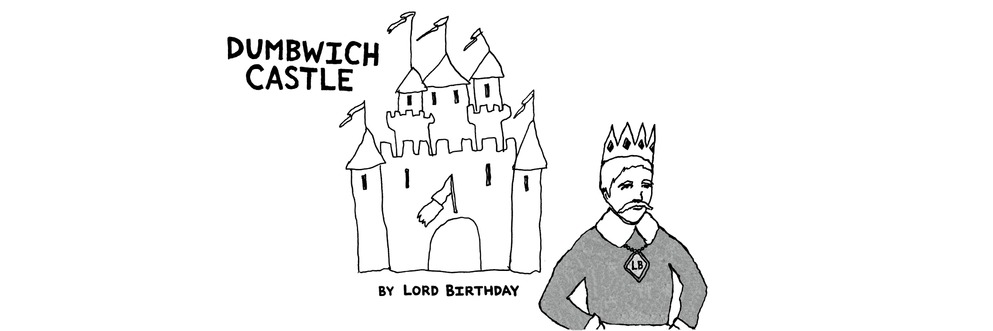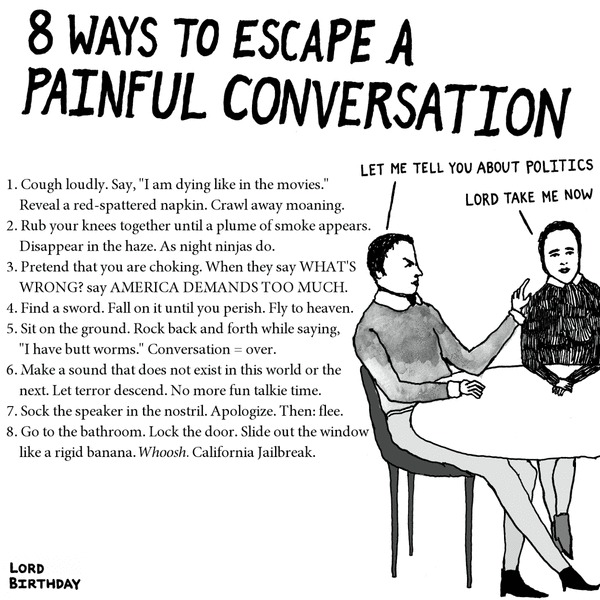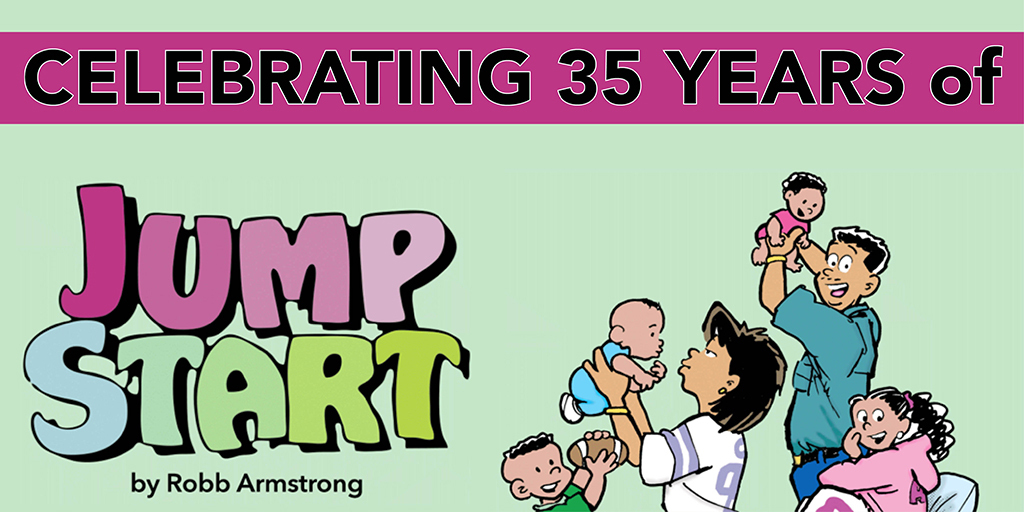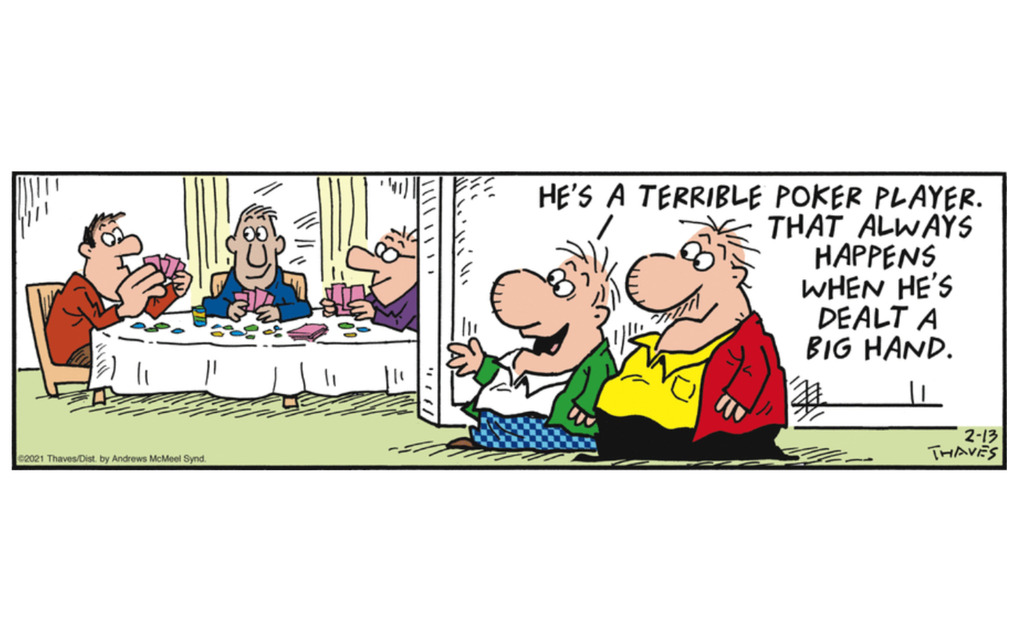Meet Your Creator: Lord Birthday Of 'Dumbwich Castle'
by Caleb GoellnerLord Birthday's been building Dumbwich Castle, line by line, for nearly two years. In that time, he's amassed a veritable kingdom of comics, along with enough subjects to fill it ten times over. Earlier this month, he expanded his borders from social media and into GoComics, where he's continued exercising his divine right to make us laugh and think in equal measure. Satire is his scepter and he wields it with gusto.
But just where did the good LB come from? Is he the descendant of a noble lineage? How did he master the modern listicle? What does he think about Broad City?
Read our full interview with LB below to find out.
GoComics: What inspired you to create Dumbwich Castle?
Lord Birthday: I was inspired, first, by the writers and poets I love: Donald Barthelme, Flannery O’Connor, Hilary Mantel, George Saunders, W.G. Sebald, Sei Shonagon, Philip Larkin, to name a few. I’ve been writing short stories (in secret) for some time, but in the summer of 2015 I stumbled upon some David Shrigley art in the Vancouver Art Gallery and I had this sudden, unexpected realization that I should be combining my writing with drawings. How to do that I didn’t really know. Since then, though, I’ve been inspired by a bunch of visual artists/cartoonists/comic artists (both new discoveries and old favorites), including Liana Finck, Amanda Michelle Smith, Mark Beyer, Ruby Elliot, Casey Jex Smith, Chris (Simpsons artist), Geneviève Castrée, The Far Side, M.K. Brown, Roz Chast, Edward Steed, Edward Gorey, Edward Lear (and probably some other Edwards I’m forgetting).
GC: You've posted some 160 comics over the past year and change, which is no small thing. Did you set out to have a regular release schedule?
LB: No, I did not have a regular release schedule when I started. In the beginning, I just tried to get as much out there as quickly as possible, since I knew there would be a learning curve (initially I was making, like, three or four drawings per week). I’ve since settled into a more reasonable pace, I think.
GC: Is Dumbwich Castle your first comic?
LB: Yes!
GC: Dumbwich Castle's format has evolved some consistency over time. What do you like about the format and what it allows you to do with words and pictures?
LB: Yes, it has evolved some consistency, that’s right. I like the current format because it allows me to work through certain creative tensions that I find productive. For example, I both love and loathe internet art and writing (listicles, memes, etc.), and so my use of those forms is both highly ironic and absolutely sincere -- at least that’s how I experience it. I feel the same way about self-help books and the advice industry more generally, and so my use of those forms is, again, meant to be satirical yet genuine. As a result, I often feel a strong sense of emotional ambiguity when I'm working -- I both hate and love what's happening on the page. This is generally a good thing, though, since I think it leads me to more interesting places than if I were motivated by just sincerity or satire alone.
GC: Your art style is simple, but there's obviously a method to your relative minimalism. Can you point to anything specific that's inspired your strip's aesthetic? Or is it more a consequence of the form you're working in?
LB: Great question. Given my age (I’m 36), I’m apparently stuck between generations -- I’m either the youngest Gen X-er or the oldest Millennial -- and I think this "in-betweenness" largely explains my aesthetic. For example, I started with sort of sad conceptual/observational drawings (Gen X cynical melancholia) but then, over time, the work has evolved into something more textual, hopeful, and immediate (Gen Y pragmatic idealism). Virginia Heffernan’s book Magic and Loss was a major influence on that evolution, actually. Among other things, it helped me shed my cynicism toward the internet as Art Destroyer and embrace it as a creative medium. The result is, I think, a visual aesthetic that is rooted in classic conceptual/observational cartooning and comic art (e.g., Roz Chast, The Far Side) combined with a textual aesthetic that is informed by the language and syntax of the internet (as exemplified by Twitter, Clickhole, Buzzfeed, Lifehack, etc.)
GC: Artists choose to use pen names for a number of different reasons. What made "Lord Birthday" the right nom de plume for you and Dumbwich Castle?
LB: Well, first, I realized just recently that the shape and rhythm of the name was inspired by the characters in Mister Rogers’ Neighborhood of Make-Believe (King Friday, Prince Tuesday, Lady Elaine Fairchilde, etc.). My fuzzy childhood memories of those characters must have surfaced when I was thinking of names. However, I also remember that the specific name "Lord Birthday" seemed to fit because, if the work was going to be both happy and sad, ironic and sincere (and that was what I believed I was aiming for), I felt like I needed a name that would reflect both dimensions, a name that would be solemn, sincere, and earnest ("Lord") but also playful, ironic, and silly ("Birthday"). So that’s where it comes from. I think.
GC: Your social media presence is interesting. You only post on one channel. You don't write captions or abuse hashtags for bot hits. You don't point to crowdfunding platforms for donations. You're stressing content marketing professionals out just by existing. How do you account for the impressive organic draw to your comics?
LB: This is a great question, and I wish I had a better answer for it. One thing I can say is that, above all else, I try to create work that contains a healthy amount of (for lack of a better term) “personality.” In fact, I never set out to make something “funny” or “entertaining” or “sad” per se. Human personality -- in all its strangeness -- is always what I’m trying to get at. That’s my best guess as to what people respond to -- that the work feels somehow human and vulnerable. I should also say that, beyond this goal, my social media presence is not very calculated -- in other words, I didn’t set out to deliberately avoid the marketing strategies you mentioned. Frankly, I just don’t know much about them. Do tell!

GC: Your comics embrace a certain amount of absurdity without sacrificing bite when your comics touch on things like sexism, toxic masculinity and other topics. How do you approach retaining your sense of humor while retaining a clear viewpoint on key issues?
LB: What a fantastic question. I’ve been thinking about it for a solid week. I don’t know exactly how to explain this, but I suppose it comes down to the role of absurdity (rather than irony or wit) in satire. I used to do more directly satirical stuff, where I was being ironic and the target was totally obvious, but something about it seemed ineffective. It felt too easy to dismiss somehow, like people could either immediately agree or disagree with it and then move on. In other words, once the punchline became clear, it became easy to discard, and the larger point never really lingered. Absurdity-driven satire, though, is a little bit harder to discard, I think, in part because it’s not always clear what specific viewpoint is being pushed in the first place. (Monty Python is, of course, probably the ultimate example of this; more recently George Saunders). As a viewer, I tend to pay more attention to satire of this kind -- the ridiculousness of it forces me to stay with it longer than I would if I had a clear, witty punchline to release me from the task of thinking more deeply about it.

GC: What makes you laugh when you're not working on comics?
LB: These days I probably watch more films and TV than anything else: Mike Leigh’s films (literally all of them) are hilarious and sad and wonderful. I think Greta Gerwig is funny and charming in everything she does (Mistress America is criminally underrated, in my opinion). I feel the same way about Steve Coogan -- the guy can do no wrong. Guy Maddin’s films are an old standby (My Winnipeg is one of the strangest, most beautifully-funny things I have ever seen). Michael Che is always brilliant (his recent stand-up special is just fantastic). Oh, and last but not least: BROAD CITY.











